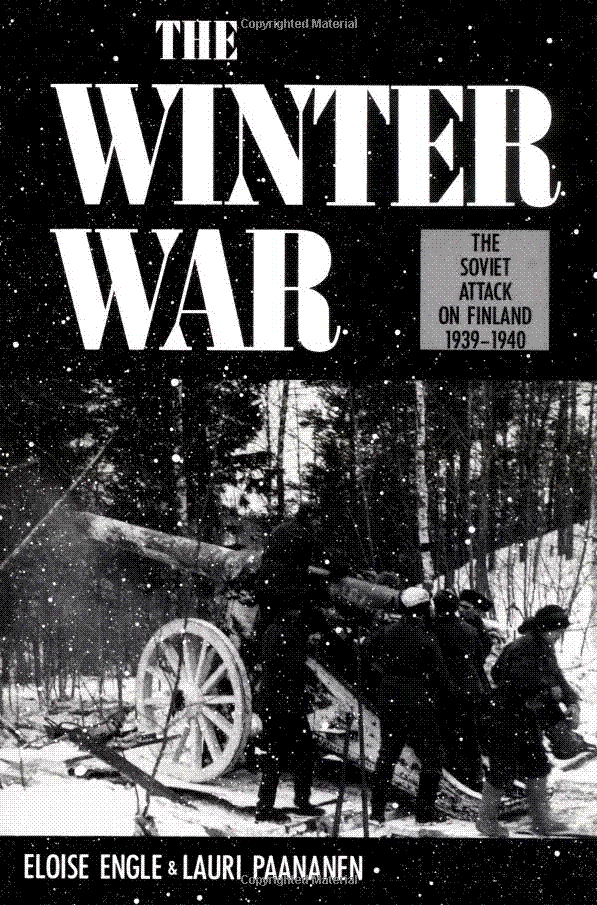The Winter War: The Soviet Attack on Finland, 1939-1940 by Eloise Engle and Lauri Paananen

The Winter War by Engle & Paananen
There are a number of books available on the now little-known Winter War between Finland and the Soviet Union, which was fought from December 1939 to March during the Sitzkrieg, and just before the Nazi invasions of Norway and Denmark. Finland held off the Soviet onslaught for 100 days before superior numbers and equipment finally wore the Finnish defenders out. Meanwhile, the world debated whether to aid the Finns, occupied as they were with Nazi aggressions.
Written back in 1973 by a husband and wife team, this small (200 pages) book is a good but relatively lightweight (compared to other books on the subject) introduction to the Russo-Finnish War of 1939-1940. It seems to be the most commonly seen book on the Winter War and is the one you can find in most libraries. It’s well written, easy to follow and read and provides a clear broad (not detailed) outline of the causes and events leading up to the outbreak of the war, and then of the war itself. A lot of the diplomatic twists are lightly treated and the overall geo-political context of the war is more or less ignored. The book itself is very much a general outline and history of the Winter War, and this, it accomplishes well.
On the war itself, the writers use a lot of first-hand anecdotes (one of the books strong points – you will find a lot of first hand material here you will not see in any of the other books on the war) as well as a summation of Finnish tactics in the unequal struggle. The book is also well-illustrated with a good collection maps and an excellent selection of black and white photographs, as well as Finnish cartoons of the times (and having worked with a group of Finns at one time a few years ago and been introduced to some drinking games of theirs, the humor rings true to this reader). The writers do however seem to romanticize the Finnish struggle somewhat and play down somewhat the final weeks of the war where the Soviet forces reorganized themselves and launched a series of overwhelming attacks.
The Russo-Finnish war was both a prelude to, and a footnote in, the Second World War. The authors more or less make this clear and also do a good job of illustrating the vacillation of both the western countries and the other Scandinavian democracies as Finland was faced with first the threat, and then the application of, overwhelming military force from the Soviet Union. This book is told from the Finnish point of view and the heroism of the Finnish Armed Forces is evident in every page of this book – the small and ill-equipped Finnish Army killed or wounded one million Russian soldiers at a cost of 25,000 Finnish dead and 55,000 wounded.
The book is very much an overview, the strategic military situation is not presented overly well, and the battles on the Karelian isthmus are covered far more lightly than the less strategic but more (from the Finnish point of view) successful battles elsewhere. The political negotiations leading up to the war are treated fairly lightly (unavoidable in a book of this length) as is the conclusion of the war. Don’t let this put you off though – the book is a great and easy to read overview with some excellent photographs, some humor, and gives a very good portrayal of the Finnish attitude to the war – determined! Incidentally, one of the authors (Lauri Paananen) was a teenager at the time of the war and served in the Finnish Home Guard.
If you’re looking for books on the Winter War with rather more meat, I would recommend following up this book with Trotter’s “A Frozen Hell”, and also with Robert Edwards “White Death” as these cover the causes and political aspects of the war more thoroughly as well as providing a clearer strategic overview of the military situation. I would also mention that this book does not cover the Continuation War – where the Finns attempted to reclaim the land that the Soviet Union had stolen through aggression. To their credit, the Finns advanced only up to their borders and no further, refusing to join the German attack on Leningrad for example. In the end, Finland lost the war due to sheer disparity in size and resources, but they gave the Soviets enough of a bloody nose that at the end of WW2, Finland was the one country aligned with Germany that was not occupied.
All in all, an excellent introduction to the subject and well worth reading, as are a number of other books on the Winter War which I will review separately.
 Copyright secured by Digiprove © 2013 Alternative Finland
Copyright secured by Digiprove © 2013 Alternative Finland


